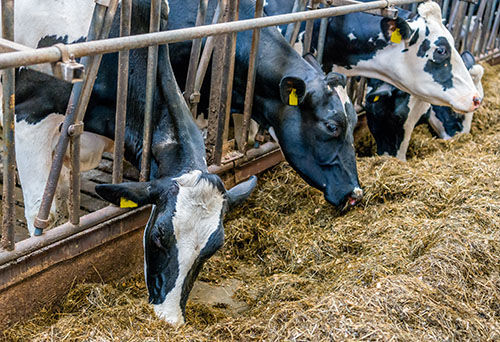Corn vs Sorghum Silage
Nov 24, 2021

As the cost of planting crops continues to rise, many dairy operations are re-evaluating corn silage as their primary forage. This has given new life to an old idea—the use of forage or grain sorghum silage.
Corn silage has been the king of forages on most dairies due to its high yield, high energy, and adaptability to most climates. Carefully evaluate the pros and cons of replacing corn with sorghum.
Tonnage yields can be equal to or possibly greater than corn with adequate nutrients and timely water. The cost of planting sorghum should be considerably less due to seed cost and a lower nutrient requirement. Also, there are Brown Mid Rib or BMR varieties available that have reduced lignin, and therefore, should generally improve digestibility. Properly managed, sorghum forages can provide acceptable energy content and can exceed corn silage in protein content.
There are other considerations when replacing corn with sorghum.
Weed control may be a challenge. There is no “Roundup Ready” (RR) technology available, so conventional chemical weed control must be used. If Johnsongrass is a problem, you should not plant sorghum since there is no chemical control available. Plan on using where RR crops have been used and weed pressure is low. Atrazine may be used for broadleaves, but for grass control you must use a “Safened” or protected seed. Contact your Co-op agronomy specialist for an exact recommendation.
Another management consideration is the timing of chop. Sorghum may have higher moisture content than corn. If it is chopped and stored too wet (over 75% moisture) it is possible that ensiling will not be adequate and the resulting quality could be inadequate. Also, due to high moisture content, an upright silo might not be usable.
If the grain head is allowed to get beyond the soft dough stage, it may be too hard for adequate digestibility. A chopper with a grain processor is recommended. It should be adjusted down to the lowest setting to break up the small sorghum seed, but even then, only about half of the grain will be affected. Getting the chop timing correct for the grain and moisture gives a short window for chopping to get them both at the optimum.
There are many varieties available. Consider only dwarf leafy varieties that have a maximum height of 7 to 8 feet. Tall and seemingly high tonnage varieties will almost always blow down creating a lodging nightmare and un-needed loss and frustration. Also, digestibility is typically lower with tall sorghums. Since sorghums are a hot weather crop, planting time is usually May through June with a planting population of 6 to 8 pounds of seed per acre.
Forage digestibility dictates milk production. Managing the crop is critical. Contact your feed and animal health specialist for aid in determining the best alternatives.
For more content like this, check out the latest issue of the Cooperator.
Corn silage has been the king of forages on most dairies due to its high yield, high energy, and adaptability to most climates. Carefully evaluate the pros and cons of replacing corn with sorghum.
Tonnage yields can be equal to or possibly greater than corn with adequate nutrients and timely water. The cost of planting sorghum should be considerably less due to seed cost and a lower nutrient requirement. Also, there are Brown Mid Rib or BMR varieties available that have reduced lignin, and therefore, should generally improve digestibility. Properly managed, sorghum forages can provide acceptable energy content and can exceed corn silage in protein content.
There are other considerations when replacing corn with sorghum.
Weed control may be a challenge. There is no “Roundup Ready” (RR) technology available, so conventional chemical weed control must be used. If Johnsongrass is a problem, you should not plant sorghum since there is no chemical control available. Plan on using where RR crops have been used and weed pressure is low. Atrazine may be used for broadleaves, but for grass control you must use a “Safened” or protected seed. Contact your Co-op agronomy specialist for an exact recommendation.
Another management consideration is the timing of chop. Sorghum may have higher moisture content than corn. If it is chopped and stored too wet (over 75% moisture) it is possible that ensiling will not be adequate and the resulting quality could be inadequate. Also, due to high moisture content, an upright silo might not be usable.
If the grain head is allowed to get beyond the soft dough stage, it may be too hard for adequate digestibility. A chopper with a grain processor is recommended. It should be adjusted down to the lowest setting to break up the small sorghum seed, but even then, only about half of the grain will be affected. Getting the chop timing correct for the grain and moisture gives a short window for chopping to get them both at the optimum.
There are many varieties available. Consider only dwarf leafy varieties that have a maximum height of 7 to 8 feet. Tall and seemingly high tonnage varieties will almost always blow down creating a lodging nightmare and un-needed loss and frustration. Also, digestibility is typically lower with tall sorghums. Since sorghums are a hot weather crop, planting time is usually May through June with a planting population of 6 to 8 pounds of seed per acre.
Forage digestibility dictates milk production. Managing the crop is critical. Contact your feed and animal health specialist for aid in determining the best alternatives.
For more content like this, check out the latest issue of the Cooperator.